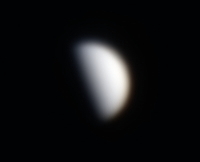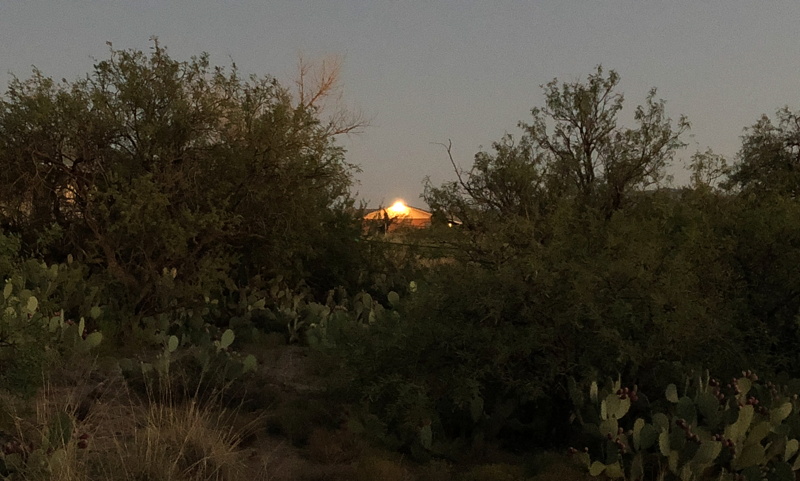SkyTracker Pro Sky Astrophotography;
Nebulae Imaging, Asteroid Imaging
Posted: 5 August 2018
|
Open: Saturday, 4 August 2018, 1854 MST Temperature: 86°F |
Session: 1267 Conditions: Mostly clear |
Equipment Used:
12" f/8 LX600 w/StarLock
2" 24mm UWA eyepiece
2" 4X Powermate
SkyTracker Pro
Focal Reducer
Camera:
D850 DSLR
1905 MST: LX600 ON, StarLock OFF, High Precision OFF.
Viewed Venus, 102X and 406X.
Mounted the D850 DSLR at prime focus + 4X Powermate. This is a stack of 84 video frames, 1080p, 60fps, DX, 1/400sec, ISO 400:

1922 MST: sunset.
Set up the D850 DSLR with a f/1.4 50mm lens on the iOptron SkyTracker Pro on the observatory patio for sky astrophotography:

On the D850 DSLR is the Vello Extension Bar, ScopeStuff Red-Dot Finder, and Vello ShutterBoss III.
1933 MST: viewed Jupiter, 102X and 406X. The four Galilean Moons were visible. Then viewed Saturn, 102X and 406X. The moon Titan was visible against the still bright sky.
I kept being annoyed by the exceedingly bright, unshielded, floodlights on the house of a neighbor to the south:

Good demonstration of Light Trespass and Light Nuisance.
1952 MST: viewed Saturn, 102X. Four moons were now visible.
2000 MST: polar aligned the SkyTracker Pro.
2004 MST: Mars rising over the hill to the southeast.
2030 MST: began preparing to image the constellation of Cygnus to show the location of the star KIC 9832227, which is predicted to be a "red nova" in the early 2020s. This is a tracked f/1.4, 30 seconds, ISO 800, White Balance 5000K, FL 50mm, image of Cygnus. The red circle shows the location of KIC 9832227.

I then switched from the 50mm lens to a 70-300mm lens. This is NGC7000 (North American Nebula), f/4.5, 2 minutes, ISO 6400, WB 5000K, FL 70mm, tracked with the SkyTracker Pro:

Mouseover or tap on image for label
I moved from the constellation of Cygnus to the constellation of Sagittarius to image M8 (Lagoon Nebula) and M20 (Trifid Nebula). This is a tracked, f/4.5, 1 minute, ISO 3200, WB 5000K, FL 70mm, image:

Mouseover or tap on image for labels
There are also two faint satellites at the right in the image.
This is a tracked, f/5.6, 1 minute, ISO 5000, WB 5000K, FL 300mm, image:

Mouseover or tap on image for labels
2113 MST: returned to the 12" telescope. Mounted the D850 DSLR at prime focus + focal reducer. Rotated the DSLR about 90° to image NGC6960 (Veil Nebula). This is a StarLock autoguided, 5 minutes, ISO 6400, WB 5000K image (cropped):

IC1396 (Elephant Trunk Nebula), StarLock autoguided, 5 minutes, ISO 6400, WB 5000K image (cropped):

2213 MST: Used SkySafari 6 Pro on the iPhone to GOTO Asteroid (1988) Delores. This asteroid is named for Dee Owings, who was the Director of the Indiana University Asteroid Program when I was an undergraduate student. I worked for her 1966-70. 2226 MST: took a StarLock autoguided, 5 minutes, ISO 6400, WB 5000K image. I then waited 1 hour before taking the next image of Asteroid Delores. During the wait the StarLock would frequently lose its lock on the guide star. Apparently the seeing was deteriorating. During the second 5 minutes exposure the lock was lost and the image ruined. I then noticed that there were clouds appearing in the southern sky (and approaching the location I was imaging). I was able to use the second image to detect motion and so was able to mark the location of Asteroid (1988) Delores:

I plan to re-image Asteroid (1988) Delores on a future session.
I had planned to image another faint asteroid this session but decided to defer it to a better night.
2340 MST: viewed Mars, 102X and 406X. There were some hints of dark surface features visible through the global dust storm. The South Polar Cap and the North Polar Hood were visible, but seeing was not good.
2348 MST: LX600 OFF.
|
Close: Saturday, 4 August 2018, 2358 MST Temperature: 82°F |
Session Length: 5h 04m Conditions: Mostly clear |
Comments are welcome using Email. Twitter users can use the button below to tweet this report to their followers. Thanks.
Cassiopeia Observatory Home Page
Copyright ©2018 Michael L. Weasner / mweasner@me.com
URL = http://www.weasner.com/co/Reports/2018/08/05/index.html
